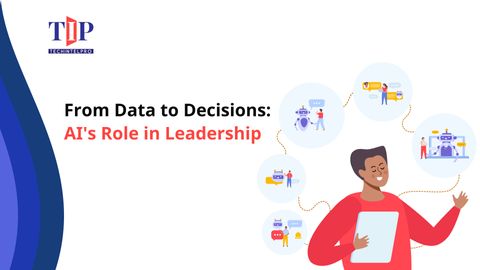In boardrooms, executive meetings, and strategic planning sessions, decision-making is quietly shifting. AI increasingly influences many enterprise decisions, from approving vendor contracts to setting dynamic pricing. For leaders, this is no longer a distant possibility: it’s a present reality with real trade-offs, opportunities, and risks. According to the State of Enterprise AI Adoption Report 2025,31% of prioritized AI use cases have reached full production
AI is already shaping key business outcomes. From automating routine approvals to optimizing pricing and supply chains in real time, these systems can act faster and process more data than any human team. The question for leaders isn’t if AI will influence decisions; it’s how much control and oversight they are willing to retain.
What AI Decision-Making Looks Like Today
Enterprises face a fundamental question – how much decision-making should AI handle? The answer depends on the type of decision and the level of risk associated with it.
Advisory AI: Many organizations utilize AI to augment human decision-making. These systems analyze data, identify patterns, and provide recommendations on inventory, risk, or vendor choices. Leaders retain final authority, using AI as a guide rather than a decision-maker.
Autonomous AI: Some AI systems act on their own. They approve low-risk transactions, adjust prices dynamically, or flag potential fraud automatically. These autonomous systems increase speed and efficiency but carry higher stakes, making oversight critical.
Drivers That Let AI Make Enterprise Decisions
Several key factors are driving AI to power enterprise decisions. Advanced AI models now process vast amounts of data with speed and accuracy. Predictive analytics, machine learning, and reinforcement learning allow systems to identify patterns and anticipate outcomes that humans might miss.
Data availability plays a critical role. Enterprises generate enormous volumes of structured and unstructured data daily. When integrated with AI, this data provides the insights needed for informed decisions. Real-time access ensures AI can act on current conditions, not outdated information.
Integration with business systems amplifies impact. AI connects directly to ERP, CRM, and operational platforms, allowing automated actions on live data. This seamless flow reduces latency and minimizes manual intervention.
Operational pressures also drive adoption. Organizations face demands for faster decisions, cost efficiency, and scalable solutions. AI handles repetitive, high-volume decisions, freeing leaders to focus on strategy.
Finally, cloud infrastructure and compute power make it possible to run complex models at enterprise scale. Together, these technological, organizational, and operational drivers create an environment where AI can reliably influence, and sometimes execute, critical business decisions.
Keeping AI Decisions Compliant
Regulatory pressure and internal policies force enterprises to ensure AI decisions meet legal and ethical standards. Organizations embed compliance controls directly into AI workflows. Systems enforce rules consistently, track every action, and generate audit trails automatically. This approach reduces human error, prevents unauthorized decisions, and provides transparency for stakeholders.
-
Policy Enforcement:
AI monitors actions against internal guidelines and external regulations. It flags deviations in real time and can halt risky transactions before they escalate. For example, AI can check procurement approvals against spending limits or confirm financial transactions comply with anti-fraud policies.
-
Auditability and Transparency:
Every AI-driven decision leaves a clear trail. Leaders can trace which data, algorithms, and rules influenced a choice. This makes audits faster and more accurate. It also allows organizations to demonstrate accountability to regulators, customers, and investors.
-
Risk Mitigation:
Compliance-integrated AI reduces exposure to fines, reputational damage, and operational errors. By consistently applying rules, AI prevents inconsistent or biased decisions that humans might miss under pressure.
-
Hybrid Oversight:
Enterprises balance AI autonomy with human review. Critical decisions remain under human supervision, while routine or low-risk actions are automated. This hybrid model ensures efficiency without compromising control.
By keeping AI decisions compliant, organizations gain more than legal safety. They build trust, improve operational confidence, and create a foundation for scaling AI adoption across business functions. In effect, compliance shifts from being a bottleneck to becoming a competitive enabler.
Key Steps in AI Decision-Making
AI transforms enterprise decisions through a structured process. Understanding these four steps helps leaders adopt AI responsibly while maximizing impact.
1. Data Collection: AI begins with data. Systems ingest structured and unstructured data from multiple sources like ERP, CRM, IoT devices, and external feeds. High-quality, timely data ensures AI analyzes relevant patterns and produces reliable insights.
2. Analysis and Modeling: Next, AI processes the data using advanced algorithms. Machine learning and predictive models identify trends, forecast outcomes, and evaluate potential scenarios. Leaders receive actionable recommendations backed by data-driven reasoning.
3. Decision Execution: AI applies insights to drive or support decisions. Low-risk tasks may be automated entirely, such as vendor selection or transaction approvals. For complex or high-stakes choices, AI presents options, while humans retain final authority.
4. Monitoring and Feedback: Post-decision, AI tracks outcomes and learns from results. Continuous monitoring identifies deviations, measures performance, and updates models to improve accuracy.
By following these steps, enterprises achieve faster, smarter, and more consistent decisions. Leaders gain not only speed and efficiency but also confidence that AI-driven decisions align with strategy and regulatory requirements.
The Future of AI Decision-Making
AI will take on more complex business decisions. It will augment, not replace, leaders. It provides real-time insights, predictive guidance, and automates routine tasks. Humans can focus on strategy, oversight, and ethics.
Decisions will become faster, data-driven, and scalable. Enterprises that use AI across finance, operations, HR, and supply chains will gain agility and a competitive edge. Hybrid models that combine AI autonomy with human oversight will dominate. They balance efficiency with accountability.
Leaders who act now will drive better outcomes and reduce risk. Those who delay may face slower decisions and missed opportunities. AI decision-making is no longer the future. It is shaping enterprise strategy today.


